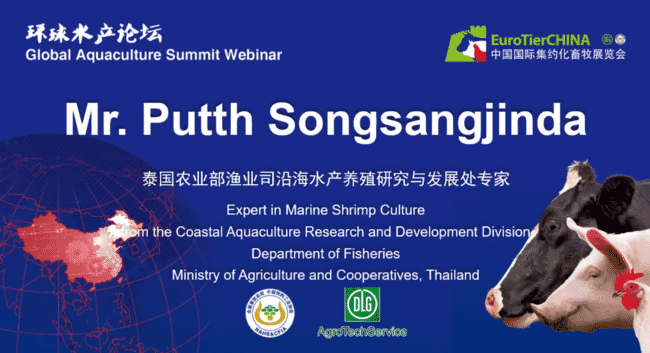
In 2019 the country’s shrimp farmers produced 304,000 tonnes of Pacific whiteleg shrimp (Litopenaeus vannamei) and 13,000 tonnes of black tiger shrimp (Peneus monodon), he explained during a webinar organised by EuroTier China.
These were produced by an industry made up of 872 hatchery and nursery farms, and nearly 24,000 grow-out farms. Productivity per million post-larvae released amounted to 8.99 tonnes for whiteleg shrimp and 8.72 tonnes for the tiger shrimp. Annual demand, he explained, fluctuated from 65 to 78 billion post-larvae per year.
Songsangjinda went on to compare the pros and cons of producing the two main shrimp species concluding that whiteleg shrimp were becoming more popular, due to the relatively low protein levels required in their diets (30-38 percent compared to 35-40 percent for monodon) and due the comparatively high productivity levels (up to 10 tonnes per hectare per crop, compared to up to 5 tonnes for the monodon). Whiteleg broodstock was also more readily available he added, although monodon were more tolerant to disease and their less intensive culture methods do make them less of a risk to the environment.
Genetic improvements
Songsangjinda then offered some insights into the whiteleg breeding programmes that the government had undertaken in order to improve growth rates and disease resistance. He outlined how the programme had sped up growth so that shrimp went from reaching 60 per kilo within 100 days to within only 70-80 days – ie a weight gain that improved from 0.17 g to 0.24 g per day. He also outlined a degree of success in breeding for resistance to whitespot and vibrio.
Feeding
According to Songsangjinda there are 22 feed mills currently producing shrimp feeds and between 50 and 100 suppliers of feed and equipment to the sector.
He also recommended the use of probiotics to establish beneficial microbial communities in shrimp ponds, to help reduce the risk of disease without the need for antibiotics and as a useful means for maintaining the pH of the water at an optimum 7.5-8.0.


